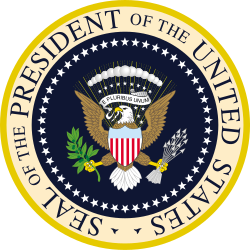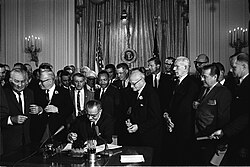President of the United States
The president of the United States (POTUS)[11] is the head of state and head of government of the United States of America and the commander-in-chief of the United States Armed Forces. The president is also the head of the executive branch of the federal government of the United States and is the chairman of the presidential cabinet.[12]
| President of the United States | |
|---|---|
 | |
 | |
| Style |
|
| Type | |
| Abbreviation | POTUS |
| Member of | |
| Residence | White House |
| Seat | Washington, D.C. |
| Appointer | Electoral College |
| Term length | Four years renewable once |
| Constituting instrument | Constitution of the United States (1789) |
| Formation | March 4, 1789[6][7][8] |
| First holder | George Washington[9] |
| Deputy | Vice President of the United States |
| Salary | $400,000 per year[upper-alpha 1] |
| Website | whitehouse.gov |
Donald Trump is the 47th and current president of the United States, in office since January 20, 2025.[13]
Eligibility and requirements
Article II, Section 1, Clause 5 of the constitution states for a person to serve as president must:
- be a natural-born citizen of the United States. [note 1]
- be at least thirty-five years old.
- be a permanent resident in the United States for at least fourteen years.
Election process and presidential terms
The president is elected by the people through the Electoral College to a four-year term, along with the vice presidential candidate or the incumbent vice president as their running mate.[14] The presidential candidate or incumbent president must have at least 270 electoral college votes in order to win the election.
Under the Twenty-second amendment to the constitution prevents anyone from being elected president more than twice. This amendment was added after Franklin Roosevelt served four terms from 1933 until his death in 1945.
President-elect of the United States
The president-elect of the United States is the candidate who has won the United States presidential election and is awaiting inauguration to become the president.
Presidential Inauguration
The president-elect and vice president-elect immediately began their four-year team on inauguration day every four years on January 20. The original inauguration date was held on March 4, but was later changed in 1933.
Executive Office of the President
The Executive Office of the President consists of the offices and agencies that support the work of the president at the center of the executive branch of the U.S. federal government. The office consists of several offices and agencies, such as the White House Office, the staff working directly for and reporting to the president, including White House staff, the National Security Council and the Office of Management and Budget.
Presidential line of succession

If the president dies, resigns, or is impeached, the vice president will succeed the presidential office and duties. Fifteen other federal government officials also rank in the succession of the president.
Abraham Lincoln, James A. Garfield, William McKinley, and John F. Kennedy were assassinated while in office. William Henry Harrison, Zachary Taylor, Warren G. Harding and Franklin Roosevelt died from illness while president. Calvin Coolidge became president, when Warren G. Harding died while in office.
Richard Nixon is the only U.S. president to have resigned from office.
Andrew Johnson, Bill Clinton, and Donald Trump are the only presidents to have been impeached.
Travel and Transportation
Residences
The White House is the official residence of the president and the first family of the United States. it has been the official residence of every U.S. president since John Adams in 1800.
Camp David is the official presidential retreat residence if the president decides to go on vacation along with his family.
Blair House is the official presidential guest house for foreign diplomats and heads of state.
Protection
The United States Secret Service is in charge with protecting the president and the first family. As part of their protection, presidents, first ladies, their children and other immediate family members are given Secret Service codenames. These codenames are used for security and safety reasons.
List of living former presidents
There are four living former presidents.
Bill Clinton
1993–2001
19 August 1946 (aged 79)George W. Bush
2001–2009
6 July 1946 (aged 79)Barack Obama
2009–2017
4 August 1961 (aged 64)Joe Biden
2021–2025
20 November 1942 (aged 83)
Presidential rankings and approval ratings
By a majority of historical sources by historians or by the American people; Abraham Lincoln, George Washington, Franklin D. Roosevelt, Dwight D. Eisenhower, Woodrow Wilson, Ronald Reagan, John F. Kennedy, Calvin Coolidge, Bill Clinton and Thomas Jefferson are ranked high on polls.[15]
On the other hand; James Buchanan, Warren G. Harding, Herbert Hoover, Richard Nixon, George W. Bush and Franklin Pierce are thought to be the worst.
Presidential libraries and museums
Since Herbert Hoover, each president has created an institutional place known as a presidential library for preserving and making available his papers, records, and other documents and materials. There are currently thirteen presidential libraries in the NARA system.
Several presidential libraries contain the graves of the president such as Richard Nixon, Ronald Reagan and George H. W. Bush.
President Of The United States Media
George Washington, the first president of the United States
President Franklin D. Roosevelt delivers a radio address in 1933
President Lyndon B. Johnson signs the 1964 Civil Rights Act at the White House on July 2, 1964, as Martin Luther King Jr. and others look on.
President Donald Trump delivers his 2018 State of the Union Address before Congress
President George H. W. Bush and Soviet President Mikhail Gorbachev sign the 1990 Chemical Weapons Accord at the White House
President Abraham Lincoln successfully preserved the Union during the American Civil War. Here he is (center) with General George B. McClellan (left), and soldiers at Antietam, on October 3, 1862
President Joe Biden with his Supreme Court appointee Justice Ketanji Brown Jackson and Vice President Kamala Harris (in background) following Brown Jackson's 2022 United States Senate confirmation
President Woodrow Wilson throws out the ceremonial first ball on Opening Day in 1916
President Bill Clinton reviews honor guards at Buckingham Palace during a 1995 state visit to the UK
President Jimmy Carter (left) debates Republican nominee Ronald Reagan on October 28, 1980, during the 1980 U.S. presidential campaign
Notes
- ↑ Foreign-born American citizens who met the age and residency requirements at the time the Constitution was adopted were also eligible for the presidency. However, this allowance has since become obsolete.
References
- ↑ "How to Address the President; He Is Not Your Excellency or Your Honor, But Mr. President". The New York Times. August 2, 1891. https://www.nytimes.com/1891/08/02/archives/how-to-address-the-president-he-is-not-your-excellency-or-your.html.
- ↑ "USGS Correspondence Handbook—Chapter 4". United States Geological Survey. July 18, 2007. Archived from the original on September 26, 2012. Retrieved November 15, 2012.
- ↑ "Models of Address and Salutation". International Trade Administration. Archived from the original on July 20, 2010. Retrieved September 4, 2010.
- ↑ "Heads of State, Heads of Government, Ministers for Foreign Affairs", Protocol and Liaison Service, United Nations. Retrieved November 1, 2012.
- ↑ The White House Office of the Press Secretary (September 1, 2010). "Remarks by President Obama, President Mubarak, His Majesty King Abdullah, Prime Minister Netanyahu and President Abbas Before Working Dinner". The White House. Retrieved July 19, 2011 – via National Archives.
- ↑ "The conventions of nine states having adopted the Constitution, Congress, in September or October, 1788, passed a resolution in conformity with the opinions expressed by the Convention and appointed the first Wednesday in March of the ensuing year as the day, and the then seat of Congress as the place, 'for commencing proceedings under the Constitution.'
"Both governments could not be understood to exist at the same time. The new government did not commence until the old government expired. It is apparent that the government did not commence on the Constitution's being ratified by the ninth state, for these ratifications were to be reported to Congress, whose continuing existence was recognized by the Convention, and who were requested to continue to exercise their powers for the purpose of bringing the new government into operation. In fact, Congress did continue to act as a government until it dissolved on the first of November by the successive disappearance of its members. It existed potentially until March 2, the day preceding that on which the members of the new Congress were directed to assemble." Owings v. Speed, 18 U.S. (5 Wheat) 420, 422 (1820)
- ↑ Maier, Pauline (2010). Ratification: The People Debate the Constitution, 1787–1788. New York, New York: Simon & Schuster. p. 433. ISBN 978-0-684-86854-7.
- ↑ "March 4: A forgotten huge day in American history". Philadelphia: National Constitution Center. March 4, 2013. Archived from the original on February 24, 2018. Retrieved July 29, 2018.
- ↑ "Presidential Election of 1789". Digital Encyclopedia. Mount Vernon, Virginia: Mount Vernon Ladies' Association. Retrieved July 29, 2018.
- ↑ Elkins, Kathleen (2018-02-19). "Here's the last time the president of the United States got a raise". CNBC.
- ↑ "POTUS - Presidents of the United States". Retrieved 2023-11-23.
- ↑ "President of the United States". Ballotpedia. Retrieved 2023-11-23.
- ↑ "President Donald J. Trump". The White House. Retrieved 2025-01-20.
- ↑ Our Government • The Executive Branch Archived 2009-01-26 at the Wayback Machine, The White House.
- ↑ "Truman and Coolidge go up, Jefferson and Jackson go down. How history remembers presidents". Los Angeles Times. 17 February 2020. Archived from the original on 2021-04-22. Retrieved 2021-04-22.
Other websites
| Wikimedia Commons has media related to Lua error in Module:Commons_link at line 62: attempt to index field 'wikibase' (a nil value).. |
- "The White House". Executive Office of the President. Retrieved November 23, 2023.
- "The White House". www.whitehouse.gov. Retrieved November 23, 2023.






















